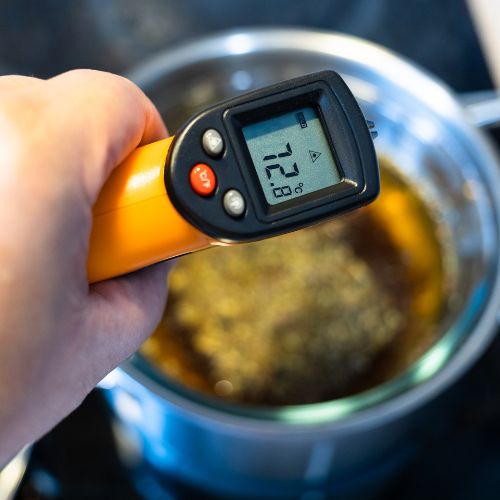Why Is Temperature So Important When Making Candles?
When it comes to making candles, the melting temperature and fragrance temperature of the wax you use can have a significant impact on the quality of your finished product. In this post, we’ll explore why these factors are important, specifically for soy wax and paraffin wax.
Soy Wax
Soy wax is a popular choice among candle makers because it is made from renewable resources and is biodegradable. However, it does have some unique characteristics that you should be aware of when using it to make candles.
- Melting Temperature:
Soy wax has a relatively low melting temperature compared to other waxes, which means it melts quickly and easily. This makes it easier to work with, especially if you’re a beginner. However, it also means that soy wax candles can be more prone to melting in hot temperatures or direct sunlight. Soy wax is more volatile and more likely to scorch when overheated, this can lead to your candles frosting and not having a good scent throw once made. - Fragrance Temperature:
Soy wax has a lower fragrance temperature than other waxes, which means that you need to be careful when adding fragrance oils. If you add fragrance oils when the wax is too hot, the oils can evaporate or become damaged, leading to a weaker scent in the finished candle. We recommend following our easy-to-use guides available on our site for each wax type.

Paraffin Wax
Paraffin wax is a petroleum-based wax that has been used for candle making for centuries. It has a higher melting point than soy wax, making it a popular choice for scented candles.
- Melting Temperature:
Paraffin wax has a higher melting temperature than soy wax, which means it can be harder to work with if you’re not experienced. It also means that paraffin wax candles are more resistant to melting in hot temperatures or direct sunlight. Paraffin is harder than soy wax. - Fragrance Temperature:
Paraffin wax has a higher fragrance temperature than soy wax, which means you can add fragrance oils when the wax is hotter without damaging the oils. However, it’s still important to be careful when adding fragrance oils to paraffin wax and to follow the manufacturer’s recommended temperature range.

In conclusion, the melting and fragrance temperatures of the wax you use are important factors to consider when making candles. Soy wax has a lower melting temperature and fragrance temperature than paraffin wax, which can make it easier to work with but also more susceptible to melting in hot temperatures and direct sunlight. Paraffin wax has a higher melting temperature and fragrance temperature, which can make it harder to work with but also more resistant to melting. By understanding these differences, you can choose the right wax for your candle making needs and create high-quality candles that will delight your customers.




